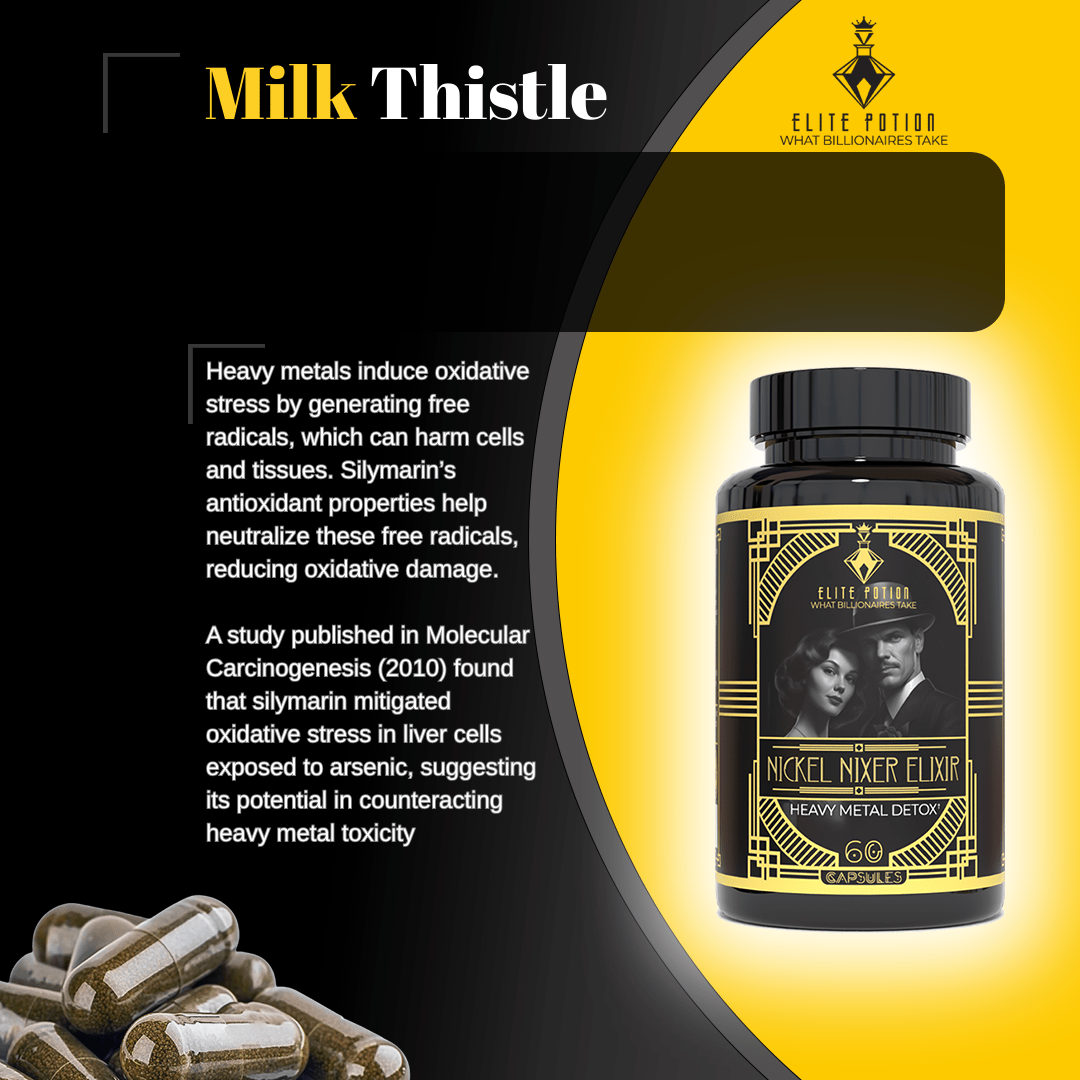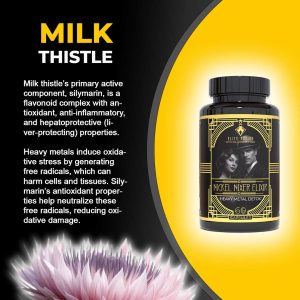
No products in the cart.


Milk thistle (Silybum marianum), a flowering herb with a rich history in traditional medicine, has garnered attention for its potential role in supporting liver health and aiding detoxification processes, including the elimination of heavy metals from the body. Known for its vibrant purple flowers and prickly leaves, this plant contains a powerful compound called silymarin, which is credited with many of its health benefits. In this article, we’ll explore how milk thistle may assist in heavy metal detoxification, its mechanisms, scientific insights, and practical considerations for its use.
Heavy metals, such as lead, mercury, cadmium, and arsenic, are naturally occurring elements that can accumulate in the body through environmental exposure—think contaminated water, air pollution, or certain foods like fish. At high levels, these metals can disrupt cellular functions, leading to oxidative stress, organ damage, and chronic health issues. The liver, a key detox organ, plays a critical role in processing and eliminating these toxins. Supporting liver function is therefore essential for effective detoxification.
Milk thistle’s primary active component, silymarin, is a flavonoid complex with antioxidant, anti-inflammatory, and hepatoprotective (liver-protecting) properties. Here’s how milk thistle may contribute to heavy metal detox:
The liver filters toxins, including heavy metals, from the blood and prepares them for excretion. Silymarin has been shown to stabilize liver cell membranes, reduce inflammation, and promote the regeneration of liver cells damaged by toxins. By enhancing liver function, milk thistle may indirectly improve the body’s ability to process and eliminate heavy metals. A 2015 review in Phytotherapy Research highlighted silymarin’s protective effects against liver damage from environmental toxins, including heavy metals like arsenic and cadmium (Vargas-Mendoza et al., 2015).
Heavy metals induce oxidative stress by generating free radicals, which can harm cells and tissues. Silymarin’s antioxidant properties help neutralize these free radicals, reducing oxidative damage. A study published in Molecular Carcinogenesis (2010) found that silymarin mitigated oxidative stress in liver cells exposed to arsenic, suggesting its potential in counteracting heavy metal toxicity (Velmurugan et al., 2010).
Milk thistle may support the liver’s phase II detoxification pathways, which involve conjugating toxins to make them water-soluble for excretion via bile or urine. While direct evidence linking milk thistle to heavy metal excretion is limited, its role in boosting glutathione—a critical detox molecule—may aid in binding and removing metals like mercury. A 2017 study in Environmental Toxicology and Pharmacology noted that silymarin increased glutathione levels in liver cells, enhancing detox capacity (Liu et al., 2017).
Some animal studies suggest that silymarin may reduce the accumulation of heavy metals in tissues. For instance, a 2016 study in Biological Trace Element Research found that silymarin decreased cadmium levels in the liver and kidneys of rats, likely by enhancing excretion and reducing absorption (Bansal et al., 2016).
Scientific Evidence and Limitations
While milk thistle shows promise, most research on its detox benefits comes from animal studies or in vitro experiments. Human studies specifically targeting heavy metal detoxification are scarce. For example:
A 2013 clinical trial in Journal of Medical Toxicology explored silymarin’s use in occupational lead exposure but found no significant reduction in blood lead levels compared to a placebo (Beigmohammadi et al., 2013).
Conversely, anecdotal reports and integrative medicine practitioners often cite milk thistle as part of detox protocols, particularly for mercury or arsenic exposure, though rigorous human trials are lacking.
The lack of large-scale human studies means milk thistle’s efficacy for heavy metal detox remains promising but not definitive. Its well-documented liver-protective effects, however, make it a valuable adjunct in detox regimens.
Milk thistle is generally well-tolerated, but some may experience mild side effects like digestive upset or headaches. It may interact with medications metabolized by the liver (e.g., statins, antidepressants), so consult a doctor if you’re on medication. People with ragweed allergies may have cross-reactivity. Avoid milk thistle if you have a known allergy or are pregnant/breastfeeding without medical advice.
Milk thistle, with its liver-supporting and antioxidant properties, offers a natural approach to supporting the body’s detoxification processes, potentially aiding in the elimination of heavy metals. While animal studies and preliminary research are encouraging, more human trials are needed to confirm its efficacy. For now, milk thistle can be a valuable part of a holistic detox strategy, especially when combined with a healthy diet, hydration, and professional guidance. Always consult a healthcare provider before starting any supplement, particularly for heavy metal detox, which may require comprehensive testing and monitoring.
Sources:
Vargas-Mendoza, N., et al. (2015). Hepatoprotective effect of silymarin.
Phytotherapy Research, 29(8), 1118-1127. DOI: 10.1002/ptr.5377
Velmurugan, B., et al. (2010). Silymarin protects against arsenic-induced oxidative stress in hepatocytes. Molecular Carcinogenesis, 49(6), 571-581. DOI: 10.1002/mc.20624
Liu, Y., et al. (2017). Silymarin enhances glutathione levels and protects against oxidative stress. Environmental Toxicology and Pharmacology, 52, 255-261. DOI: 10.1016/j.etap.2017.04.015
Bansal, A. K., et al. (2016). Protective role of silymarin in cadmium-induced toxicity. Biological Trace Element Research, 171(2), 438-447. DOI: 10.1007/s12011-015-0552-5
Beigmohammadi, M. T., et al. (2013). Silymarin in the treatment of lead poisoning. Journal of Medical Toxicology, 9(4), 345-350. DOI: 10.1007/s13181-013-0327-9
Note: Always verify supplement safety and consult professionals for detox protocols.
These statements have not been evaluated by the Food and Drug Administration. This product is not intended to diagnose, treat, cure, or prevent any disease.
Copyright © 2026, Elite Potion
Leave a comment